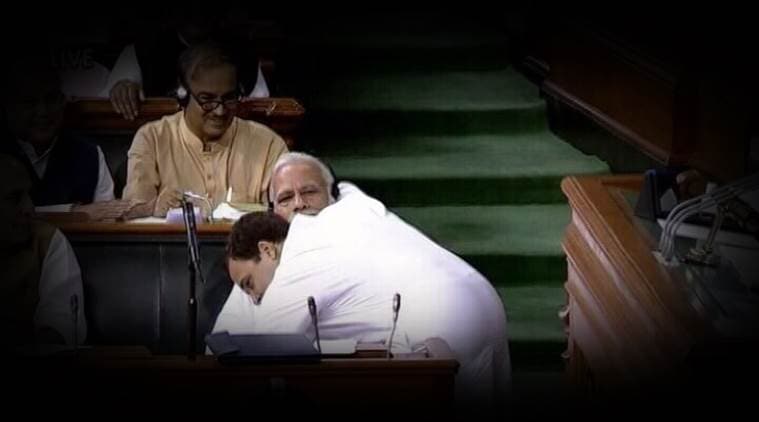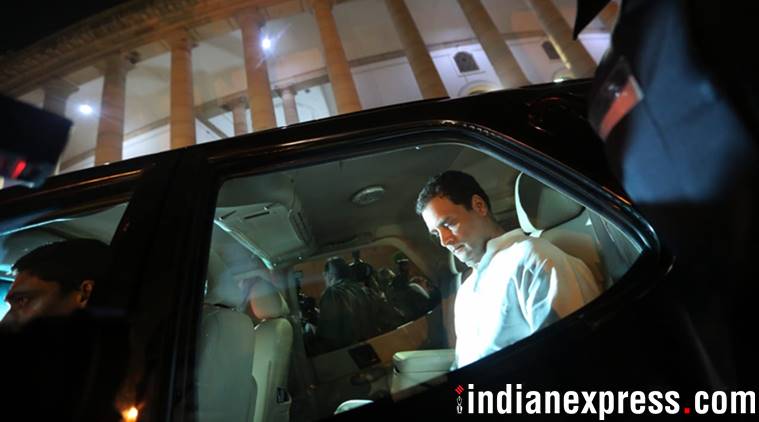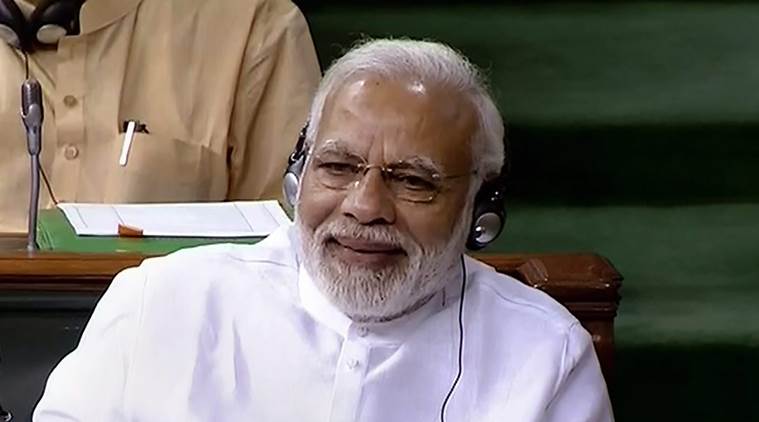 Rahul Gandhi targetted the central government by zooming in on issues like agrarian crisis, corruption and crony capitalism. (Photo Courtesy: Lok Sabha TV)
Rahul Gandhi targetted the central government by zooming in on issues like agrarian crisis, corruption and crony capitalism. (Photo Courtesy: Lok Sabha TV)
The 2018 no-confidence motion debate in Lok Sabha Friday outlined the broad battlelines of the 2019 general elections. While Congress president Rahul Gandhi unveiled his narrative for the Opposition parties, Prime Minister Narendra Modi set the tone and tenor of the likely BJP electoral pitch.
Speaking ahead of the Prime Minister, the Congress president refrained from referring to ‘secularism’, invoking instead the theme of protecting ‘Ambedkar’s Constitution’ as the main narrative to indicate his broad theme for the 2019 campaign.
Follow No Confidence motion in Parliament Highlights
“Jahan bhi dekho, kahin na kahin, kisi na kisi Hindustani ki hatya ho rahi hai, peeta jaa raha hai, dabaya jaa raha hai. Jab bhi kisi ko mara jaata hai, dabaya jaata hai, kuchla jaata hai, peeta jaata hai, toh yeh sirf us vyakti par hamla nahin ho raha hai balki Ambedkarji ke samvidhan par aur is House par hamla ho raha hai,” Gandhi said in an impassioned speech during the debate on the no-confidence motion in Lok Sabha which, at the end of the 12-hour discussion, was defeated 126-325 votes.
PM Modi, Amit Shah fear loss of power will start other processes, says Rahul Gandhi
This was the closest he came to point at violence against minorities and Dalits, cow vigilantism and mob lynching —
incidents over which his party has come down heavily against the ruling BJP over the last four years. In contrast, the Prime Minister, sensing that the Opposition was not keen to project a prime ministerial candidate in the run-up to 2019, framed the no-confidence debate as a veiled attempt by Rahul Gandhi to push his own candidature for the top job. Modi, in fact, suggested that this floor test was an attempt to test waters, and which political parties were aligned with the Congress and Rahul Gandhi.
Read | Ruckus during PM Modi’s speech: For ex-ally TDP, it ends in the Well
“Apne kunbe ko jamane ki koshish ki hai… Please do test your potential allies, but do not use the pretext of the no-confidence motion for this,” Modi said. This was a clear attempt to make it a Modi vs Rahul binary for the next Lok Sabha elections. By framing the 2019 contest in such a manner, he also sought to put any future grand Opposition alliance in a piquant position on the issue of leadership.
 Rahul Gandhi after the opposition lost the no-confidence motion in Parliament. (Express Photo by Tashi Tobgyal)
Rahul Gandhi after the opposition lost the no-confidence motion in Parliament. (Express Photo by Tashi Tobgyal)
The Prime Minister not only kept his attack focused on Rahul Gandhi and the Congress but also used the floor test to make light of their challenge. In particular, he mimicked and criticised the Congress president on several counts to dismiss his attempts at emerging as the leader of the Opposition for the 2019 elections.
Describing Gandhi’s endeavour as a “childish” misadventure, Modi again chose to attack the Nehru-Gandhi dynasty, reminding the country about the the instability the Congress caused in the past by propping governments. He recalled the fate of the governments led by Charan Singh, Chandrashekhar, Deve Gowda and I K Gujral to drive home his political message. This appeared an attempt to spook regional parties eyeing a shot at power in 2019. Later, BJP president Amit Shah too took to Twitter after the government won the floor test. He called it a victory of democracy against the “negative politics of dynasties”.
During the debate, Rahul Gandhi, while keeping out the ‘secularism’ word, underlined his Hindu values to counter the attempt by the BJP and its affiliated groups to project Congress as a pro-Muslim party. “Main aapko dil se dhanyavad karna chahta hun ki aapne mujhe mera dharm sikhaya. Aapne mujhe Shivji ka matlab samjhaya aur aapne mujhe Hindu hone ka matlab samjhaya,” he said.
 Prime Minister Narendra Modi reacts to Congress President Rahul Gandhi’s speech during a debate on ‘no-confidence motion’ in Lok Sabha during the Monsoon session of Parliament. (PTI)
Prime Minister Narendra Modi reacts to Congress President Rahul Gandhi’s speech during a debate on ‘no-confidence motion’ in Lok Sabha during the Monsoon session of Parliament. (PTI)
It appeared that while Modi projected an image of a leader in control, the Congress president was trying hard to seem like a leader who had a heavier compassion quotient. While the Prime Minister repeatedly highlighted the achievements of his government’s schemes, Gandhi’s focus was on a clutch of issues including the Rafale deal row, ‘suit-boot’ government, the PM’s foreign trips, jumla-strike, women’s safety, and welfare of Dalits and tribals. While this was his 2019 narrative, Gandhi’s speech did not touch on UPA’s past achievements like NREGA, Food Security Act, RTI.
The Congress president also used the discussion to wade into the BJP and NDA by differentiating the Modi-Shah duo from the BJP, ostensibly to encash NDA apprehensions to the advantage of the Congress.
“The Prime Minister and the president of the BJP can simply not afford to lose power because the moment they lose power, other processes will start against them. So, the Prime Minister and the president of the BJP act out of fear,” he said, bracketing Modi and Shah together to tap into grievances within the NDA and caution potential future allies.
Modi, on his part, used his speech to reach out to potential allies where he spoke kindly about JD(S) chief H D Deve Gowda, praised the stance of TRS (led by Telangana Chief Minister K Chandrasekhar Rao) during the bifurcation of Andhra Pradesh and suggested how the YSR Congress Party had trapped TDP chief Chandrababu Naidu.
He also praised Deve Gowda and SP founder Mulayam Singh Yadav’s rise from their humble backgrounds — this was his way of signalling that there was no rancour in the BJP despite the SP and JD(S) humbling the party in political battles recently. Even NCP chief Sharad Pawar came in for subtle praise from the Prime Minister — another signal that the BJP was viewing regional parties differently in the run-up to 2019.